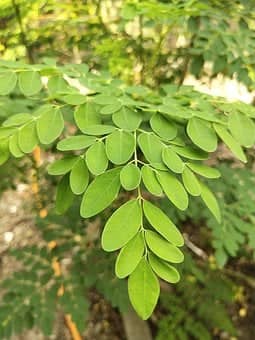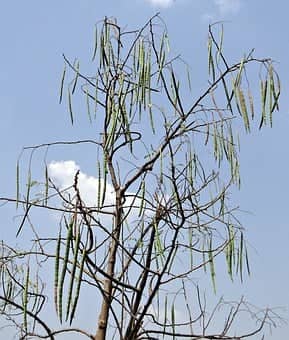12 to 13 tonnes of pods are obtained by planting 700 plants in 1 acre and a net profit of Rs 195400 can be achieved in drumstick farming. This is a very profitable cultivation farmer shall try it once after checking all the needful requirements for this tree. The basic requirements are given in this post.
Quick notes– Investment = Rs 195400, net profit = Rs 1,45,400, pod production 1 acre = 12 to 13 tonnes, growing time = 6 to 8 months.
Moringa tree information
Scientific name – The scientific name of the drumstick tree is ‘Moringa Oleifera’ belonging to the family “Moringacea” and the tree is popularly known as the moringa tree also.
Tree byproducts – The tree is grown for its edible pods, leaves and flowers. Its vegetables are rich in nutrients high in calcium and contain antioxidants.
Tree height – Drumstick trees are not very tall trees, they are medium size trees of 10 to 12 metres in height.
Trunk – The tree trunks are about 35 cm to 45 cm in girth or diameter.
Stem and branches – The tree consists of thick corky fragile stems. Usually, moringa tree branches seem to droop with leaves and leaflets.
Moringa leaves – This tree is mainly cultivated for its pods and leaves. Its leaves are non-pointed small to medium roundish in shape
Pods – Drumstick pods are long and pendulous in shape with a length of 20 cm to 80 cm. Pods taste like green beans but are a bit sweeter, this vegetable is mostly used in ‘Sambhar’ a popular “South Indian Recipe”.
Flowers – The tree bears bisexual flowers of yellow, creamy and white colour with sweet fragrance and fruit seeds are trigonous in shape.
Facts – Moringa flowering time is not fixed, it depends on region to region in South Indian conditions the drumstick flowering occurs once a year from January to August. Whereas, in Central Kerala, flowering occurs Feb to March, in Coimbatore it is from March to May and in the Bangalore region, flowering occurs from July to Sep. However, in conditions with constant rainfall flowering can occur twice a year throughout the year.
Read this – Drumstick farming profit in India
Growing zones
Drumstick trees are grown in tropical and subtropical regions throughout the world, they are easy to grow and easily available. The tree has a drought-resistant capability, drumstick is a fast-growing perennial vegetable tree.
Usually, the trees are cut down to 1 to 2 metres under commercial farming by doing this plants regrow with the pods and leaves can be kept within arms reach.
Project Report
The cost per acre calculation is given below.
- Seed cost = Rs 800.
- Land preparation cost = Rs 5000.
- Labour cost = Rs 15000.
- Manure and fertilizer cost = Rs 12000.
- Herbicides and pesticides cost = Rs 3000.
- Irrigation cost = Rs 5000.
- Drip irrigation cost = Rs 50,000
- Plant protection charges = Rs 6000.
- Miscellaneous cost = Rs 2000.
- Total cost = Rs 104,600.
Drumstick farming profit per acre
- Pod price per kg = Rs 20 to Rs 35.
- Drumstick yield per acre (pods 1st year) = 12 to 13 tonnes.
- Let’s assume 10 tons of pods in 1 acre.
- 1 ton =1000 kg.
- 10 tons =10,000 kg.
- Let’s take the price 20 per kg.
- Pod profit = Rs 20 x 10,000 kg = 2 lakhs.
- Now calculate the leaf profit.
- Moringa leaves yield per acre = 12 to 20 tons.
- Let’s take average production = 10 tons.
- If moringa leave price is Rs 10 per kg.
- Then Rs 10 x 10,000 kg = Rs 100000 (1 lakh).
- Profit = Pod + leaf.
- Profit = 2 lakh + 1 lakh = 3 lakh.
- Net Profit = profit – cost.
- Net Profit = Rs 3 lakh – Rs 104600.
- Net Profit = Rs 195400.
Note – So this is the moringa leaf + pod calculation in 1 acre. This is the assumption of the project report to give you an idea so that you can prepare your business plan. However, the average pod production may go up to 20 tonnes in the best farming environment.
Read it – Sandalwood plantation in India

Drumstick farming practices
You must know the correct information to practice on the ground, all the required info is given below to start the drumstick cultivation from the beginning.
Different varieties
PKM1, PKM2, Chavakachcheri, Chem Murungai, Kudumiyanmalai 1 (KM-1), Mulanur Moringa, Valayapatti Moringa, ODC. ODC is the latest variety mostly used in current farming.
Varieties are classified into two types: Paranniel types and annual types.
Perennial types – However, this type of cultivation has been practiced for centuries but this type of tree is not preferred for commercial farming because it takes a longer time to grow. These trees also require greater rainfall and are less resistant to pests and disease. This type of moringa tree cultivation in India is usually practised through cuttings.
Annual types – This type is cultivated in the current cultivation and is preferred for commercial farming. India is the largest producer of drumsticks and annual types are propagated through seeds and are fast growers that reach maturity in less time.
They are also capable of adapting to various soil and different climate conditions. However, it might not be the most costly tree in India but early maturity, higher yield and fast growth are the features of this tree. In India, moringa cultivation in Andhra Pradesh, Tamil Nadu, Odisha etc is done on a large scale. Seeds are preferred for commercial farming.
Climate conditions
Tropical and subtropical climates are suitable for this pod-growing tree.
Temperature – Ideal temperature is 25°C to 35°C. A temperature of more than 40 degrees Celsius is not good for moringa tree growth.
Read this – African Mahogany tree price
kind of soil
6.0 to 7.0 is the ideal soil pH. This tree can grow in a wide range of soils but red soils and black soils are the most preferable soil types due to high seeding potency.
Water requirements
Fewer water requirements result in reduced cost of cultivation and water saving. Due to less water, they can easily survive in drought conditions for 6 months. However, soil conditions should be maintained, too dry and too wet soils will result in flower shredding. The irrigation cycle is given below.
1st 3 months – Irrigation required once a week.
After 3 months – Irrigation is required once in 10 to 12 days.
Rainy season – Watering is not required.
Note – Maintain substantial soil moisture levels during the flowering period and avoid water stagnation in drumstick farms.
Land preparation
Ploughing more than 2 times is required for drumstick cultivation, deep ploughing is recommended while land preparation. While last ploughing 20 times of (FYM) farmyard manure needs to be mixed with soil. Moreover, pits sizes for perennial cultivars and annual cultivars are classified differently. After digging the pits are filled with the best potting mix for moringa. Place 2 seeds in one place and pick the seed that turns red in colour and throw it out of the farm because this seed is not useful at all.
Soil mix – 10 to 15 kg FYM or compost + 100-gram nitrogen + 200 gram phosphorus + 50 gram potassium. After preparing this soil mix fill the pits with this mixture before the onset of the monsoon.
Read this – Poplar plantation in India
Pits size for perennial cultivars – 45 x 45 x 45 cm with 6.0 x 6.0 metre spacing.
Pits size for annual cultivars – Pits are dug with a spacing of 2.5 x 2.5 metres.
Spacing
Ideal spacing – 5 feet by 12 feet.
Plant-to-plant spacing is 5 x 5 feet.
Row-to-row spacing 12 feet.
With this spacing 700 to 750 plants can be sowed easily.
600-gram seeds can be sowed in 1 acre.
Propagation
Seed and cuttings are the main propagation methods in moringa trees, planting methods are explained below.
Seed propagation – Due to suitability this method is mostly used in annual cultivar types. In this farm practice in North America, healthy moringa seeds are sown approximately 3 cm deeper inside the pits. With a proper irrigation cycle formula, germination occurs within 8 to 10 days.
Cutting propagation – The stem-cutting propagation method is used for perennial cultivars due to suitability. This practice is done when a tree stops producing pods, cut the branches for preparing the stem cuttings and this will also result in the fresh growth of the used tree. For planting the moringa cuttings in each pit first select the healthy moringa tree then cut the branches 120 to 150 cm in length and 5 to 12 cm in diameter.
Place one-third part of the cuttings inside the pit, correct insertion of the plant cut is required for proper root and plant growth. You should apply the application of cow dung at the top end of the cut branch before planting; this will protect the cutting from pests and diseases.
Do you know – What is a doctor tree
How many drumstick plants per acre
Plants are classified according to the spacing:
4 feet – 1000 moringa plants.
6 x 12 feet – 750 to 800 moringa plants.

Fertilizer requirements
Making fertilizer is not that difficult, however, it takes time to gain knowledge and correct research. Fertilizer for plants is classified according to the stages.
After 3 months of seed sowing – 100 Gram Urea + 100 gram superphosphate + 50 gram muriate of potash fertilizer. Apply the fertilizer mixture to each pit or plant.
Flowering season – Apply 100 grams of urea per plant or per pit.
Fungicide – Mancozeb fungicide (M-45) is recommended especially during flower blooming and the first rain after flowering will prevent flower drop.
A monthly two-time fungicide spray is necessary to get rid of pests and diseases.
Seed treatment
To control seed-borne disease you should treat the seed with approved biopesticides or chemicals before sowing. Soak the seeds for a full night and sow them another day in the early morning. For increased seed vigour and growth, you can use seed treatment with 100-gram azo spirillum for 650 grams of seeds.
This is one of the best farming practices for early germination. To increase the profit you should practice the seed treatment more carefully. Sulphur and neem oil spray is used in the seed treatment process.
Remember under best farming practices including ideal temperature, soil, fertilizer and disease management moringa leaves yield per acre can be expected higher and an average production may go up to 25 tonnes or more.
Pest and disease
Bud worm (Noorda Moringa).
Lead caterpillar (Noordablitealis).
Hairy caterpillar (Eupterotemollifera).
Pod fly (Gitona Distigma).
Bark caterpillar (Indarbela Tetraonis).
Moringa yield per acre
Pod production per acre (1st year) = 12 to 13 tonnes.
Pods production per acre (2nd year) = 15 to 20 tonnes.
Moringa leaf yield per acre = 15 to 20 tonnes.
Single pod price – Rs 3 to Rs 4.
Leaves production per acre – 12 to 20 tons.
Dry leaves are the most expensive product of the moringa tree and under the best farming practices, the average moringa leaves production in India may increase.
Moringa leaves price in India per kg – Rs 25 to 50.
Pods price per kg – Rs 25 to 35.
Dry leaves price in India – Rs 75 to 100.
Other names
Apart from moringa, it is also known as benzoil tree, horseradish tree due to its various qualities.
Other names – Moringa tree, Horseradish tree, Ben oil tree, Moringa drumstick tree.
Moringa tree – The tree is called moringa tree due to its long slender, triangular seed pods.
Horseradish tree – Horseradish’s name falls due to the drumstick roots taste that resembles the taste of horseradish.
Benzoil tree – Drumstick tree is also known as the ben oil tree or benzoil tree due to the oil extraction from moringa seeds.
Marketing
As you know best farm management practices, crop care, and choosing the best varieties are important aspects of moringa farming. But do you know marketing is equally important for the farming business? If you have grown your crop with immense care but fail to sell it completely then your effort is not worth it.
In today’s digital world, you must create a website for marketing your products. Website creation is not as difficult as people think. If you want we can help you to create your first professional website. You can reach us via email given on the contact us page. You can also find various website creators at fiverr.com. If you need a website then you can avail of good discounts at greengeeks or cloudways both are the best and trusted.

FAQ
How many moringa trees can I plant per acre?
One can plant 700 to 750 moringa plants per acre with a spacing of 5 by 12 feet.
What is the lifespan of a drumstick tree?
It can survive nearly 10 to 12 years and farmers are getting benefited throughout these years.
How long does a drumstick take to grow?
It needs 6-8 months from the plantation period to reach the first harvesting.
What should be the drumstick plantation distance?
5 feet distance between 2 drumstick plants and 12 feet for row-to-row distance.
How many drumstick seeds per acre?
The seed rate should be 650 grams or half a kg in 1 acre.
How much water is required for moringa farming?
Less water is required in moringa cultivation, weekly 1 irrigation is enough in black soil.
How much production in 1 acre in the first year?
12 to 13 tonnes of drumstick can be produced under good farm management practices in the first year and after first-year production will increase up to 15 to 16 tonnes per acre.
What is the drumstick tree yield per tree?
1 drumstick tree can produce nearly 13 to 15 kg yield per tree.
What is the average market price of drumsticks?
A minimum of Rs 20 to 25 per kg is the average market price of the drumstick.
From where I can buy drumstick seeds or plants?
You can buy drumstick seeds from your nearest agriculture market, store or farm. The contact number of drumstick farmer Sandeep Kadam is 9075721000.
Is drumstick farming profitable?
Farmers of south India including Maharashtra, Gujarat, Kerala, and Karnataka are already earning between Rs 1 lakh to 2.50 lakhs per acre as per their farming practices.
When does the tree start bearing pods?
The tree starts producing pods after 6 months of the plantation.
What do moringa pods taste like?
Drumstick pods have distinct flavours and taste like green been but slightly sweeter.
Where moringa is popular in India?
They are very popular in South Indian cuisine, vegetable (PODS) is majorly used in a South Indian dish called sambhar.
Read More
